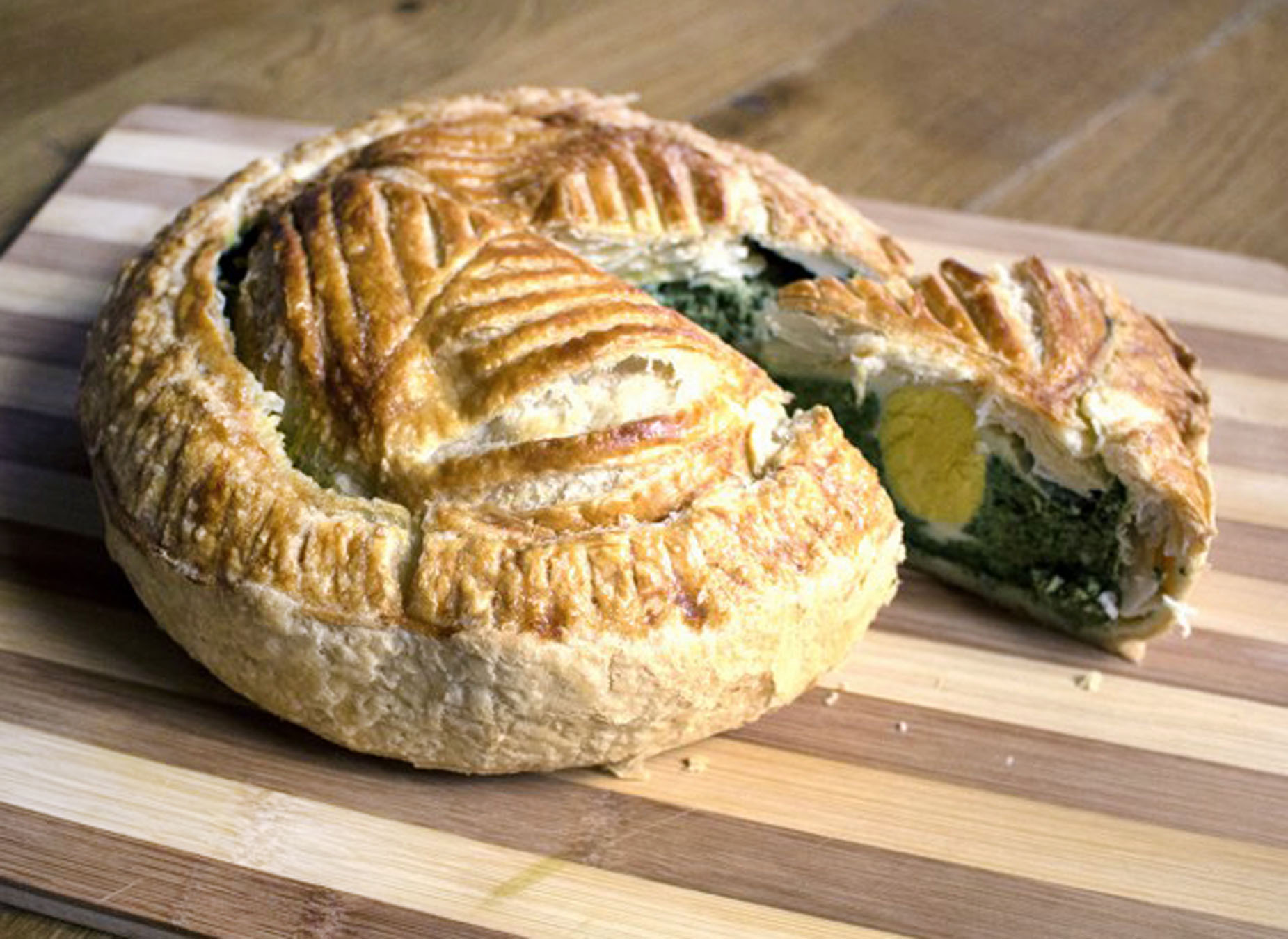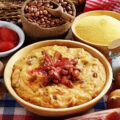Torte di Pasqua, translates to Easter cake, but it is also includes Easter pies, both savory and sweet. These traditional Italian delicacies signify the end of the Lenten fasting period and mark the renewal and rebirth of Easter. The variations of Torte di Pasqua differ greatly throughout the country, but you will find that Colombo Pasquale, or the Easter Dove, is the unofficial Easter dessert found throughout Italy.
There are numerous legends as to the origin of the cake. The most popular one dates to 1176 when two doves, representing the Holy Spirit, miraculously appeared above a battlefield, spurring the Lombards to victory over the despised Holy Roman Emperor Frederick Barbarossa. Colombo Pasquale is prepared like panettone, allowing the batter to rise over many hours. It is flavored with diced candied orange and lemon rinds and decorated with sliced almonds and an almond glaze, then baked in a dove-shaped mold.
In southern Italy, one of the delights of Easter is Pizza Chiena, a delicious pie stuffed with meats, cheeses and eggs. In the Neapolitan dialect, it means “full pie.” This Torte di Pasqua can trace its history to 17th century Naples and it swiftly became a staple of the Easter holiday. The traditional dough is made with flour, eggs, salt, shortening and milk. The filling requires eggs and various types of cheeses such as aged provolone, mozzarella, ricotta, plus freshly grated Parmigiano-Reggiano and Pecorino Romano, as well as meats including sopprassata and mortadella.
In Naples, the traditional Easter dessert is La Pastiera Napoletana. This wheat-berry Easter cake is made with sweet and creamy custard, candied orange and lemon peels and served under a lattice-top pastry crust. Also called Pastiera Napoletana di Grano, it was first baked in the Neapolitan San Gregorio Armeno convent. As a symbol of the Resurrection, a nun whose name has been lost to the ages, wanted to bake a cake with the scent of orange blossoms that grew in the convent’s gardens. She mixed wheat with ricotta cheese, added eggs, candied citron, aromatic spices and water infused with orange blossoms. The nuns of the ancient convent were considered to be geniuses when it came to the complex preparation of the Pastiera and would bake many pies to sell to wealthy Neapolitan families at Easter. The Pastiera has to be cooked some days in advance, usually no later than Maundy Thursday, in order to allow its delicate fragrance to emerge, which results in its unique flavor.
As with many great dishes, this one has a legend associated with it. Maria Theresa of Savoy, wife of King Ferdinand II, ruler of Sicily and southern Italy in the early 19th century, was nicknamed “the Queen who never smiles.” One Easter, the court chef prepared Pastiera for her. The Queen was so enraptured by the torta that a beautiful smile came to her face. The King reputedly sighed and remarked, “Now I have to wait until next Easter to see her smile again.”
The Isle of Capri is famous for its dark chocolate Lemon Torta Caprese, but for Easter, Torta Caprese Bianca is prepared. The cake is very soft and made with white chocolate and almond flour, with an intense flavor from lemons grown on the nearby Amalfi Coast. It was created in the early 1900s by a pastry chef on Capri when he inadvertently used almond flour in the recipe. The happy mistake became a resounding success!
In Sicily, one of the favorite Easter desserts is Torta di Ricotta Dolce. A version was first enjoyed by the Romans almost 2,000 years ago. This Sicilian Easter cheesecake is made with a sweet pie crust and a filling made with sweetened ricotta, farro wheat and flavored with lemon zest and cinnamon. Farro wheat is one of the oldest of wheats and was the type grown when Sicily was the breadbasket of the Roman Empire.
Torta di Riso or Rice Pie, has a very long history and is a quintessential northern Italian dessert. It originated in Emilia Romagna. In Bologna, it has been served following Easter processions since the 15th century. It would be a great oversight not to mention the influence of le mondine, the young women of peasant families who in the early 1900s could be found knee-deep in flooded Arborio rice fields of the Po River valley. The girls were compensated with rice for each day of work. Naturally, the Italian women in Emilia Romagna came up with creative ways to cook the rice by combining the Arborio with local milk from the same cows that produce Parmigiano Reggiano cheese. During the 20th century, the popularity of Torta di Riso spread beyond Bologna and into the kitchens of Italians throughout the north.
A Recipe to Drive the Cat Away
Torta Pasqualina is another well-known traditional Easter dish and is originally from Liguria, but it is now popular all over the peninsula. The origin of this dish has been lost to time, but it has been documented back to 1500. It is very likely to have been an Easter meal enjoyed by Christopher Columbus. The original recipe contained artichoke, but variations also use spinach or chard leaves. In many parts of Italy, it is made with puff pastry, but in Liguria, Pasqualina is made using thin layers of unleavened dough. Originally thirty-three sheets were used, one for every year of Jesus’ life. The pastry is then stuffed with the sautéed greens, cheeses and eggs. Pasqualina is best eaten cold; perhaps that is why over time the dish has become not only a symbol of Easter, but of La Pasquetta, when Pasqualina is often brought along for picnics and outings on Easter Monday.
Ciaramicola is a colorful shortcake from the Umbrian province of Perugia. It is a rustic cake with a baked meringue topping and colored sprinkles. Young women bake it for their fiancés on Easter Sunday as a sign of their love. The cake is highly symbolic; beneath the pure white meringue hides a red-hot heart. When preparing the batter, a splash of Alchermes liqueur turns the interior a bold scarlet color. The liqueur has its origins in the Middle Ages and is flavored with cinnamon, cloves, vanilla and rose water. It originally obtained its bright red color from dye extracted from the cochineal insect.
One of the most unusual Easter specialty dishes is called Polenta e Osei, “songbirds in polenta.” The dish is from Bergamo in the Lombardy region and although it is not a pie, there is also an Easter cake from Bergamo called Polenta e Osèi Dolce, which contains neither polenta nor songbirds. The former is made using pheasant, squab, partridge, wood pigeons and quails which are roasted and served over polenta. This dish can be traced back to the 15th century and the cookbook Libro de arte coquinaria.
Although it is doubtful that any readers will be preparing this Bergamaschi dish, you should note that Polenta e Oséi Dolce is a delicious cake and the most renowned sweet specialty of Bergamo. The dessert was created in 1910 by the imaginative baker Alessio Amadeo who created a mound-shaped rum-flavored sponge cake with layers of chocolate hazelnut cream. The cake is then dusted with crystals of yellow sugar to resemble polenta. At the top of the cake are a flock of osei, or birds; however, in this dessert, they are made from marzipan covered in chocolate!





